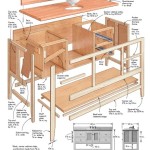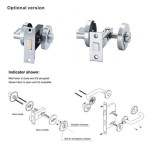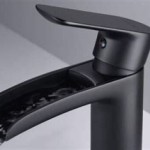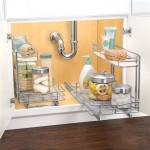How To Fix A Leaking Bathroom Delta Faucet
A dripping faucet, particularly in a bathroom, is more than just an annoyance. It represents wasted water, a potential increase in water bills, and, if left unattended, could lead to more significant plumbing issues like mineral buildup and damage to sink fixtures. A commonly encountered brand in many homes is the Delta faucet. While known for their durability, Delta faucets are not immune to leaks. This article provides a comprehensive guide on diagnosing and fixing a leaking Delta bathroom faucet, covering various models and common causes.
Before commencing any repair work, safety is paramount. The initial step involves turning off the water supply to the faucet. Typically, shut-off valves are located directly beneath the sink. Turn both the hot and cold water valves clockwise until they are fully closed. If individual shut-off valves are unavailable, the main water supply to the house must be turned off. Following the water shut-off, open the faucet to relieve any remaining pressure in the lines. Place a stopper in the sink drain to prevent small parts from being lost during disassembly.
Identifying the Leak Source and Faucet Type
The first crucial step towards resolving a faucet leak is accurately identifying the source and the type of Delta faucet. This determination will streamline the troubleshooting process and guide the selection of appropriate repair steps and replacement parts. Leaks can manifest in various locations, each suggesting a different underlying problem.
A leak emanating from the base of the faucet, where it meets the sink, often indicates a problem with the O-rings or the faucet body itself. Water dripping from the spout suggests worn-out seats, springs, or a faulty cartridge (in cartridge-style faucets). Leaks around the handle often point to worn O-rings or seals within the handle assembly. Furthermore, observing when the leak occurs provides valuable clues. Does the faucet leak constantly, or only when it is turned on or off? The answers help narrow down the potential causes.
Delta offers a range of faucet types, each utilizing a different internal mechanism. The most common types include:
* Ball Faucets: Characterized by a single handle that controls both water flow and temperature by moving a ball-shaped component within the faucet body. * Cartridge Faucets: These also feature a single handle, but utilize a cartridge containing internal seals to regulate water flow and temperature. * Two-Handle Faucets: These faucets have separate handles for hot and cold water and typically employ compression valves or ceramic disc cartridges. * Ceramic Disc Faucets: These utilize two ceramic discs that slide over each other to control water flow. These are known for their durability and resistance to leaks.Identifying the specific faucet type allows for targeted troubleshooting and ensures the correct replacement parts are obtained. If unsure, consult the faucet's installation manual or search online using the faucet's model number, often found on the faucet body or in the documentation.
Repairing a Single-Handle (Ball-Type) Delta Faucet
Single-handle ball-type Delta faucets are prone to leaks due to wear and tear on internal components. The most common culprit is the wearing of the rubber seats and springs located beneath the ball assembly. To repair this type of faucet, the following steps are necessary:
Disassembly: Begin by loosening the setscrew located on the side of the handle. Use an Allen wrench to remove the setscrew, allowing the handle to be lifted off. Next, unscrew the cap and collar assembly. This might require a special wrench designed for this purpose. Beneath the cap, the ball assembly will be visible. Lift the ball assembly out of the faucet body. Using a small screwdriver or pliers, carefully extract the rubber seats and springs from the faucet body. These components are usually located in small recesses at the base of the faucet body.
Inspection and Replacement: Carefully inspect the removed seats and springs. If they appear worn, compressed, or damaged, replace them with new ones. A Delta faucet repair kit typically includes replacement seats, springs, and O-rings. Also, inspect the ball assembly for any signs of wear or corrosion. If the ball assembly is damaged, it should be replaced as well. Examine the faucet body for mineral buildup or corrosion. Clean any deposits using a mild cleaning solution and a soft brush.
Reassembly: Place the new springs and seats into the recesses in the faucet body. Ensure they are properly seated. Reinstall the ball assembly, aligning it correctly with the faucet body. Screw the cap and collar assembly back onto the faucet body, tightening it securely. Reattach the handle and tighten the setscrew. It is essential to avoid overtightening the setscrew as this can damage the handle or the faucet body.
Testing: Turn the water supply back on slowly. Check for leaks around the base of the faucet, the spout, and the handle. If leaks persist, double-check the installation of the seats, springs, and O-rings. Readjust the cap and collar assembly if necessary.
Repairing a Cartridge-Type Delta Faucet
Cartridge-type Delta single-handle faucets also frequently develop leaks due to cartridge wear. The cartridge contains internal seals that can degrade over time, leading to dripping or reduced water flow. Repairing this type of faucet involves replacing the cartridge.
Disassembly: Similar to the ball-type faucet, the first step involves removing the handle. Locate and loosen the setscrew on the side of the handle using an Allen wrench. Remove the handle. Some models may have a decorative cap covering the screw, which needs to be carefully pried off first. Once the handle is removed, a retaining clip or nut will be visible, securing the cartridge in place. Remove the retaining clip or nut using pliers or a wrench. With the retaining clip or nut removed, the cartridge can be carefully pulled out of the faucet body. It may be necessary to gently rock the cartridge back and forth to loosen it. If the cartridge is stuck, a cartridge puller tool can be used.
Inspection and Replacement: Examine the removed cartridge for signs of wear or damage. Look for cracks, breaks, or worn seals. Compare the old cartridge to the new replacement cartridge to ensure they are identical. Replacement cartridges are typically model-specific, so it is crucial to obtain the correct one. Before installing the new cartridge, clean the faucet body to remove any mineral buildup or debris. Apply a small amount of plumber's grease to the O-rings on the new cartridge to facilitate smooth installation and create a watertight seal.
Reassembly: Align the new cartridge correctly with the faucet body. Push the cartridge firmly into place until it is fully seated. Reinstall the retaining clip or nut to secure the cartridge. Reattach the handle and tighten the setscrew. Again, avoid overtightening the setscrew.
Testing: Turn the water supply back on slowly and check for leaks. Test the faucet's water flow and temperature control to ensure the new cartridge is functioning correctly. If leaks persist, double-check the cartridge installation and ensure it is properly seated and secured.
Addressing Leaks at the Faucet Base
Leaks occurring at the base of the faucet, where it meets the sink, generally stem from deteriorated O-rings or a loose connection between the faucet body and the mounting surface. This type of leak necessitates a different approach than repairing leaks originating from the spout or handle.
Disassembly: To address this leak, access to the underside of the sink is required. First, disconnect the water supply lines from the faucet tailpieces. Place a bucket underneath the sink to catch any remaining water. Next, loosen the mounting nuts and washers that secure the faucet to the sink. These nuts are usually located on the faucet tailpieces and can be accessed with a basin wrench. Once the mounting nuts are removed, the faucet can be lifted from the sink.
Inspection and Replacement: Upon removing the faucet, inspect the O-rings or rubber gasket located at the base of the faucet body. If they appear worn, cracked, or flattened, they need to be replaced. Replacement O-rings can be purchased at most hardware stores. Clean the mounting surface of the sink to remove any dirt, debris, or old sealant. Apply a bead of plumber's putty or silicone sealant around the base of the faucet before reinstalling it. This will create a watertight seal between the faucet and the sink.
Reassembly: Carefully position the faucet back onto the sink, aligning it properly. Reinstall the mounting nuts and washers, tightening them securely. Avoid overtightening the nuts, as this can crack the sink or damage the faucet. Reconnect the water supply lines to the faucet tailpieces. Turn the water supply back on slowly and check for leaks around the base of the faucet and the water supply connections. If leaks persist, tighten the mounting nuts or water supply connections further. Ensure the sealant has properly cured before using the faucet extensively.
In situations characterized by persistent leaks despite replacing the commonly worn parts, closer inspection of the faucet body itself is warranted. Cracks, corrosion, or other forms of damage to the faucet body can compromise its ability to maintain a watertight seal, regardless of how new the internal components are. In such cases, replacing the entire faucet may be the most effective and economical solution in the long run.
Proper maintenance can significantly extend the lifespan of a Delta faucet and prevent leaks. Regularly cleaning the faucet to remove mineral buildup and avoiding excessive force when operating the handle can help prevent premature wear and tear on internal components. When replacing parts, using genuine Delta replacement parts is recommended, as these are designed to fit and function correctly with the specific faucet model.

How To Repair Leaking Dripping Delta Faucet Diyplumbing Serviceplumbing Tappplumbing

How To Fix A Leaky Delta Style Bathroom Faucet

How To Fix Leaky Bathroom Handle Delta Faucet Model 4530 Series Hard Water

Simple Ways To Fix A Leaky Delta Bathroom Sink Faucet

How To Rebuild A Delta Single Handle Faucet

Simple Ways To Fix A Leaky Delta Bathroom Sink Faucet

Sink Faucet Repair Delta Bathroom Drips

Simple Ways To Fix A Leaky Delta Bathroom Sink Faucet

How To Fix A Leaky Bathtub Faucet Delta Shower Cartridge L Replace

Learn How To Fix A Leaky Faucet Delta Bathroom
Related Posts






